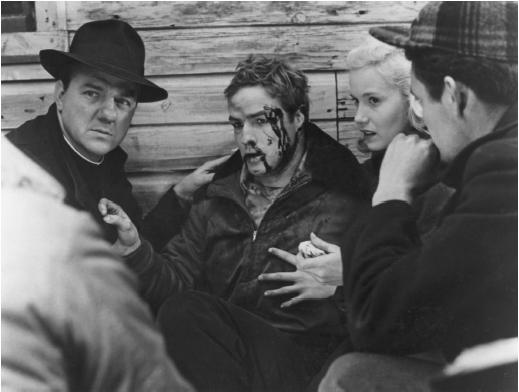
I’m an inveterate Robert Mitchum fan, sharing David Thomson’s opinion that he is “untouchable” in the history of the cinema. So when I discovered that he re-teamed with his Out of the Past co-star Jane Greer in The Big Steal, I jumped all over it. I was not disappointed.

Mitchum (playing Army Lt. Duke Halliday) and Greer (playing tougher-than-she-looks Joan, quickly nicknamed Chiquita by Halliday) get their rapid-fire banter started early when Halliday tries to shake her down in the bathroom:
Joan:“You might be accustomed to taking group showers, but I’m not.”
Halliday: “Where’s Fiske?”
Joan: “Taking the parrot for a walk.”
The humor is strong throughout—I enjoyed this classic Mitchum line, out of the side of his mouth as he regards a priceless stone artifact: “Looks like something you get for knocking down a milk bottle.”
The early action takes place in a little town quite reminiscent of Tampico in The Treasure of the Sierra Madre. There's a heady mix of possible good guys and grifters in the hot sun as Chiquita and Halliday are joined by the pencil-moustached hustler Fiske and Army Captain Blake in pursuit of a suitcase full of money. Mitchum is in cantinas again, looking over his shoulder against that long nose. Even though there's nothing quite as memorable as Greer's arrival out of the light in Out of the Past, the first act bustles right along.

The Big Steal comes into focus as the shadow of a ceiling fan stirs the hot air of a police station. Halliday is trying to convince the authorities that the money has been stolen from him. The Mexican police speak excellent English of course, one even an “alumnus” of the University of California system (the Lieutenant and the Inspector debate singular versus plural in Latinate words amongst other grammatical pickles). Their banter is a wily way of obscuring the Inspector's sharp intuition--he knows what the gringos will do before they know themselves. In a later scene, Fiske, Halliday and Chiquita are all nervously drinking coconuts with the Inspector and all changing their minds at the same time. He plays the role of the cat playing with the mice who thinks they are cats. The Inspector, and by extension Mexico, is always there, abiding.
The central motif of The Big Steal is a contrast between the impatience of the gringos and the serenity of the natives. One running gag, established early in the film, has Halliday repeatedly dashing out of the barbershop before getting his shave (though he takes the time to toss a coin over his shoulder for the service almost rendered—he’s a good American after all). Donkeys and cows in the street are always moving exactly as fast as they want to, slowing down frustrated Americans behind the wheel. Part of the reason Halliday wins out in the end is his acclimation to the Mexican pace of life (which dovetails nicely with Mitchum’s famous lassitude). At the end of a long car chase, Halliday and Chiquita elude their pursuer not by outracing him, but by setting a stream of goats loose across the road. This gives us what I imagine to be our only filmic image of Mitchum the Goatherd.

I also want to call out a particular cut. There’s a lovely fade from a group moving through a hotel archway to a woman rowing a boat filled with flowers. Just as the characters presumably scatter to different rooms once inside the hotel, the flower lady throws white blooms in every direction. It’s stunning high art in an otherwise no-frills 77 minute sprint.

Of course, after the climax (which is brilliantly foreshadowed, by the way), one wants to know if Halliday and Chiquita will stay together. They have a discussion in the park and, suffice to say, they come to an accord. If you can imagine an ending less subtle than the train entering the tunnel in North by Northwest, this is it.












